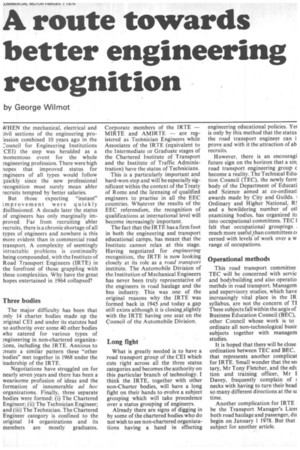A route towards better engineering recognition
Page 39

If you've noticed an error in this article please click here to report it so we can fix it.
by George Wilmot
WHEN the mechanical, electrical and ivil sections of the engineering pro'ession combined 10 years ago in the ouncil for Engineering Institutions CE!) the step was heralded as a -nomentous event for the whole engineering profession. There were high lopes that improved status for engineers of all types would follow iuickly since the new professional recognition must surely mean abler recruits tempted by better salaries.
But those expecting "instant" improvement were quickly lisillusioned. A decade later the status of engineers has only marginally improved. Far from recruiting abler recruits, there is a chronic shortage of all types of engineers and nowhere is this more evident than in commercial road transport. A complexity of seemingly intractable problems is continually being compounded, with the Institute of Road Transport Engineers (IRTE) in the forefront of those grappling with these complexities. Why have the great hopes entertained in 1964 collapsed?
Three bodies
The major difficulty has been that anly 14 charter bodies made up the priginal CEI and under its statutes had ao authority over some 40 other bodies ivho catered for various types of engineering in non-chartered organizations, including the IRTE. Anxious to reate a similar pattern these "other bodies" met together in 1968 under the leadership of the IRTE.
Negotiations have struggled on for nearly seven years and there has been a wearisome profusion of ideas and the formation of innumerable ad hoc organizations. Finally, three separate bodies were formed; (i) The Chartered Engineer; (ii) The Technician Engineer; and (iii) The Technician. The Chartered Engineer category is confined to the original 14 organizations and its members are mostly graduates. Corporate members of the IRTE — MIRTE and AMIRTE — are registered as Technician Engineers while Associates of the IRTE (equivalent to the Intermediate or Graduate stages of the Chartered Institute of Transport and the Institute of Traffic Administration) have the status of Technicians.
This is a particularly important and hard-won step and will be especially significant within the context of the Treaty of Rome and the licensing of qualified engineers to practise in all the EEC countries. Whatever the results of the EEC referendum, the recognition of qualifications at international level will become increasingly important.
The fact that the IRTE has a firm foot in both the engineering and transport educational camps, has meant that the Institute cannot relax at this stage. Having negotiated for engineering' recognition, the IRTE is now looking closely at its role as a road transport institute. The Automobile Division of the Institution of Mechanical Engineers has never been truly representative of the engineers in road haulage and the bus industry. This was one of the original reasons why the IRTE was formed back in 1945 and today a gap still exists although it is closing,slightly with the IRTE having one seat on the Council of the Automobile Division.
Long fight
What is greatly needed is to have a road transport group of the CEI which cuts right across all the three status categories and becomes the authority on this particular branch of technology. I think the IRTE, together with other non-Charter bodies, will have a long fight on their hands to evolve a subject grouping which will take precedence over a status grouping of engineers.
Already there are signs of digging in by some of the chartered bodies who do not wish to see non-chartered organ iszations having a hand in effecting engineering educational policies.. Yei is only by this method that the status the road transport engineer can i prove and with it the attraction of ab recruits.
However, there is an encouragi future sign on the horizon that a sin; road transport engineering group c become a reality. The Technical Edul tion Council (TEC), the newly form body of the Department of Edueati and Science aimed at co-ordinati awards made by City and Guilds. 1 Ordinary and Higher National, 11! and a bewildering number of otl examining bodies, has organized it into occupational committees. TEC I felt that occupational groupings . much more useful thancommittees cc cerned with levels of work over a w range of occupations.
Operational methods
This road transport committee TEC will be concerned with servic and bodybuilding and also operatio methds in road transport. Managem and supervisory studies, which have increasingly vital place in the IR syllabus, are not the concern of T1 These subjects fall within the aegis of Business Education Council (BEC), other Council whose work is to ordinate all non-technological busir subjects together with managem studies.
It is hoped that there will be close ordination between TEC and BEC, that represents another complicat for IRTE. Small wonder that the sec tary, Mr Tony Fletcher, and the ech.: tion and training officer, Mr Davey, frequently complain of necks with having to turn their head so many different directions at the g time.
Another complication for IRTE be the Transport Manager's Licei both road haulage and passenger, du begin on January 1 1978. But that subject for another article.












































































































































